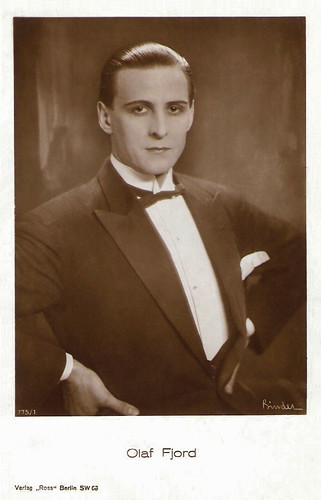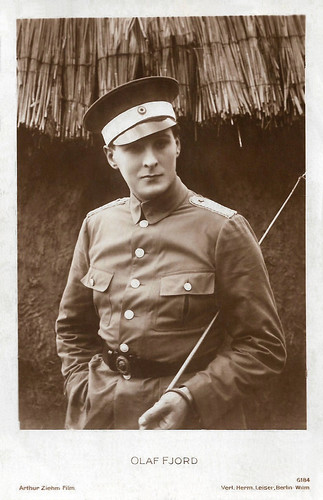Olaf Fjord (1897-1945) was an Austrian film actor, director and producer. He appeared in numerous Austrian, German, French, and Czech silent films.

German postcard by Ross Verlag, no. 775/1, 1925-1926. Photo: Alex Binder.

German postcard by Ross Verlag, no. 997/1, 1925-1926. Photo: H. Gärtner, Berlin. Collection: Didier Hanson.

German postcard by Ross Verlag, no. 997/2, 1925-1926. Photo: H. Gärtner, Berlin.

German postcard by Ross Verlag, no. 1329/1, 1927-1928. Photo: Atelier Balàzs, Berlin.

German postcard by Ross Verlag, no. 3845/1, 1928-1929.
Olaf Fjord was born Ämilian Maximilian Pouch in Graz, Austria in 1897 (some sources mention 1895). At the age of three, he went with his parents to Bosnia-Herzegovina and grew up there in a Benedictine monastery. During the First World War, he served in the military for a while. Still during the war, he settled in Vienna and took singing lessons. He also completed a business apprenticeship.
In the winter of 1917-1918, he was discovered by the Danish director Einar Zangenberg for the film. He took the stage name Olaf Fjord and during his film career, he often described himself as Norwegian. He appeared in many silent Austrian films but also started to direct films, including the short Paulchen, das Millionenbaby/Pauly, the Million Dollar Baby (Olaf Fjord, 1920). In 1921 he played Ludwig II of Bavaria in the biography Ludwig II. (Otto Kreisler, 1921) with Gina Puch-Klitsch.
In Germany, he appeared in the historical epic Monna Vanna (Richard Eichberg, 1922) starring Lee Parry and based on the play by Maurice Maeterlinck. The success of the film led to bigger parts in German productions such as Der Mann um Mitternacht/The Man at Midnight (Holger-Madsen, 1924) with Hella Moja, Zwei Menschen/Two People (Hanns Schwarz, 1924) opposite Agnes Esterhazy, and Frauen, die nicht lieben dürfen/Women, not allowed to love (Géza von Bolvary, 1925).
He moved to France for Mon coeur au ralenti/Change of Heart (Marco de Gastyne, 1928) starring British actress Annette Benson, Le désir/The Desire (Albert Durec, 1928), filmed in Algeria, and La madone des sleepings/Madonna of the Sleeping Cars (Marco de Gastyne, Maurice Gleize, 1929).
A huge success was the Czech drama Erotikon/Seduction (Gustav Machatý, 1929) with Ita Rina. Not in the least because a film scene showed bare breasts, a trick the director later repeated with the young Hedy Lamarr in his sensational Ekstase/Ecstasy (Gustav Machatý, 1933).

Croatian (former Kingdom of Yugoslavia) postcard by Jos. Caklovic, Zagreb, Bromografija, no. 16. Photo: Pan-Film, Zagreb. Olaf Fjord and Sabri Mahir in Der gestohlene Professor/The Stolen Professor (Emil Justitz, 1924). It was her only film role.

German postcard by Verlag Hermann Leiser, no. 6289. Photo: Ewe-Film. Olaf Fjord in Frauen, die nicht lieben dürfen (Géza von Bolváry, 1925).

German postcard by Verlag Hermann Leiser, Berlin-Wilm., no. 6184. Photo: Arthur Ziehm Film. Olaf Fjord in Ich hatt' einen Kameraden/I had a comrade (Conrad Wiene, 1926).

German postcard by Verlag Hermann Leiser, Berlin, no. 6290. Photo: Natan Film Production, Paris. Fjord acted e.g. in in the Pathé-Nathan production Mon cœur au ralenti/Change of Heart (Marco de Gastyne, 1928)

Austrian postcard by Iris-Verlag, Berlin, no. 5379. Photo: Bieber, Berlin. Collection: Didier Hanson.
After the introduction of the sound film, Olaf Fjord appeared both in the German production Kameradschaftsehe/Companionate Marriage (Heinz Schall, Josef Medeotti-Bohác, 1929) with Ernst Verebes, and in the Czech language version, Kamarádské manzelství (Josef Medeotti-Bohác, 1930).
In the following years, his parts became smaller, as in the all-star drama 1914, die letzten Tage vor dem Weltbrand/1914: The Last Days Before the War (Richard Oswald, 1931) starring Albert Bassermann. Alles um eine Frau/Everything for a Woman (Alfred Abel, 1935) with Charlotte Susa and Gustav Diessl, was his final film as an actor.
Fjord had found another occupation though as a director and as a producer. First, he produced an early version of the often adapted material Ferien vom Ich/Holiday From Myself (Hans Deppe, 1934) with Hermann Speelmans, and Pan (Olaf Fjord, Josef Rovenský, 1937) with Christian Kayssler, a film adaptation of a novel by the Norwegian Nobel Prize-winning author Knut Hamsun.
Both films, he produced in Nazi Germany. His attempt to produce an adaptation of the novel Gösta Berlings Saga by Selma Lagerlöf failed in 1938.
In January 1939 he emigrated to the United States, where he lived for a while. Olaf Fjord died in Vienna, Austria in 1945, at the age of 47.

German postcard by Ross Verlag, no. 775/2, 1925-1926. Photo: Alex Binder.

German postcard by Ross Verlag, Berlin, no. 1753/2, 1925-1926. Photo: Manuel Frères, Paris.

German postcard by Ross Verlag, no. 4299/1, 1929-1930. Photo: D.L.S. / Rosenfeld-Film. Olaf Fjord as Count Orlof in Tarakanova (Raymond Bernard, 1930).

German postcard by Ross Verlag, no. 4299/2, 1929-1930. Photo: D.L.S. / Rosenfeld-Film G.m.b.H. Olaf Fjord in Tarakanova (Raymond Bernard, 1930).

Austrian postcard by Iris Verlag, no. 5659. Photo: R. Tomatis, Nice / E. Weil & Co. Olaf Fjord in Tarakanova (Raymond Bernard, 1930).

German postcard by Ross Verlag, no. 4588/1, 1929-1930. Photo: Atelier Richard Frolik, Prague.

French postcard by Editions Cinémagazine, no. 501. Photo: Olaf Fjord in the French film La madone des sleepings/Madonna of the Sleeping Cars (Marco de Gastyne, Maurice Gleize, 1929).
Sources: Thomas Staedeli (Cyranos), Wikipedia (German) and IMDb.
This post was last updated on 20 March 2024.

German postcard by Ross Verlag, no. 775/1, 1925-1926. Photo: Alex Binder.

German postcard by Ross Verlag, no. 997/1, 1925-1926. Photo: H. Gärtner, Berlin. Collection: Didier Hanson.

German postcard by Ross Verlag, no. 997/2, 1925-1926. Photo: H. Gärtner, Berlin.

German postcard by Ross Verlag, no. 1329/1, 1927-1928. Photo: Atelier Balàzs, Berlin.

German postcard by Ross Verlag, no. 3845/1, 1928-1929.
A Norwegian Austrian
Olaf Fjord was born Ämilian Maximilian Pouch in Graz, Austria in 1897 (some sources mention 1895). At the age of three, he went with his parents to Bosnia-Herzegovina and grew up there in a Benedictine monastery. During the First World War, he served in the military for a while. Still during the war, he settled in Vienna and took singing lessons. He also completed a business apprenticeship.
In the winter of 1917-1918, he was discovered by the Danish director Einar Zangenberg for the film. He took the stage name Olaf Fjord and during his film career, he often described himself as Norwegian. He appeared in many silent Austrian films but also started to direct films, including the short Paulchen, das Millionenbaby/Pauly, the Million Dollar Baby (Olaf Fjord, 1920). In 1921 he played Ludwig II of Bavaria in the biography Ludwig II. (Otto Kreisler, 1921) with Gina Puch-Klitsch.
In Germany, he appeared in the historical epic Monna Vanna (Richard Eichberg, 1922) starring Lee Parry and based on the play by Maurice Maeterlinck. The success of the film led to bigger parts in German productions such as Der Mann um Mitternacht/The Man at Midnight (Holger-Madsen, 1924) with Hella Moja, Zwei Menschen/Two People (Hanns Schwarz, 1924) opposite Agnes Esterhazy, and Frauen, die nicht lieben dürfen/Women, not allowed to love (Géza von Bolvary, 1925).
He moved to France for Mon coeur au ralenti/Change of Heart (Marco de Gastyne, 1928) starring British actress Annette Benson, Le désir/The Desire (Albert Durec, 1928), filmed in Algeria, and La madone des sleepings/Madonna of the Sleeping Cars (Marco de Gastyne, Maurice Gleize, 1929).
A huge success was the Czech drama Erotikon/Seduction (Gustav Machatý, 1929) with Ita Rina. Not in the least because a film scene showed bare breasts, a trick the director later repeated with the young Hedy Lamarr in his sensational Ekstase/Ecstasy (Gustav Machatý, 1933).

Croatian (former Kingdom of Yugoslavia) postcard by Jos. Caklovic, Zagreb, Bromografija, no. 16. Photo: Pan-Film, Zagreb. Olaf Fjord and Sabri Mahir in Der gestohlene Professor/The Stolen Professor (Emil Justitz, 1924). It was her only film role.

German postcard by Verlag Hermann Leiser, no. 6289. Photo: Ewe-Film. Olaf Fjord in Frauen, die nicht lieben dürfen (Géza von Bolváry, 1925).

German postcard by Verlag Hermann Leiser, Berlin-Wilm., no. 6184. Photo: Arthur Ziehm Film. Olaf Fjord in Ich hatt' einen Kameraden/I had a comrade (Conrad Wiene, 1926).

German postcard by Verlag Hermann Leiser, Berlin, no. 6290. Photo: Natan Film Production, Paris. Fjord acted e.g. in in the Pathé-Nathan production Mon cœur au ralenti/Change of Heart (Marco de Gastyne, 1928)

Austrian postcard by Iris-Verlag, Berlin, no. 5379. Photo: Bieber, Berlin. Collection: Didier Hanson.
Another occupation
After the introduction of the sound film, Olaf Fjord appeared both in the German production Kameradschaftsehe/Companionate Marriage (Heinz Schall, Josef Medeotti-Bohác, 1929) with Ernst Verebes, and in the Czech language version, Kamarádské manzelství (Josef Medeotti-Bohác, 1930).
In the following years, his parts became smaller, as in the all-star drama 1914, die letzten Tage vor dem Weltbrand/1914: The Last Days Before the War (Richard Oswald, 1931) starring Albert Bassermann. Alles um eine Frau/Everything for a Woman (Alfred Abel, 1935) with Charlotte Susa and Gustav Diessl, was his final film as an actor.
Fjord had found another occupation though as a director and as a producer. First, he produced an early version of the often adapted material Ferien vom Ich/Holiday From Myself (Hans Deppe, 1934) with Hermann Speelmans, and Pan (Olaf Fjord, Josef Rovenský, 1937) with Christian Kayssler, a film adaptation of a novel by the Norwegian Nobel Prize-winning author Knut Hamsun.
Both films, he produced in Nazi Germany. His attempt to produce an adaptation of the novel Gösta Berlings Saga by Selma Lagerlöf failed in 1938.
In January 1939 he emigrated to the United States, where he lived for a while. Olaf Fjord died in Vienna, Austria in 1945, at the age of 47.

German postcard by Ross Verlag, no. 775/2, 1925-1926. Photo: Alex Binder.

German postcard by Ross Verlag, Berlin, no. 1753/2, 1925-1926. Photo: Manuel Frères, Paris.

German postcard by Ross Verlag, no. 4299/1, 1929-1930. Photo: D.L.S. / Rosenfeld-Film. Olaf Fjord as Count Orlof in Tarakanova (Raymond Bernard, 1930).

German postcard by Ross Verlag, no. 4299/2, 1929-1930. Photo: D.L.S. / Rosenfeld-Film G.m.b.H. Olaf Fjord in Tarakanova (Raymond Bernard, 1930).

Austrian postcard by Iris Verlag, no. 5659. Photo: R. Tomatis, Nice / E. Weil & Co. Olaf Fjord in Tarakanova (Raymond Bernard, 1930).

German postcard by Ross Verlag, no. 4588/1, 1929-1930. Photo: Atelier Richard Frolik, Prague.

French postcard by Editions Cinémagazine, no. 501. Photo: Olaf Fjord in the French film La madone des sleepings/Madonna of the Sleeping Cars (Marco de Gastyne, Maurice Gleize, 1929).
Sources: Thomas Staedeli (Cyranos), Wikipedia (German) and IMDb.
This post was last updated on 20 March 2024.
No comments:
Post a Comment